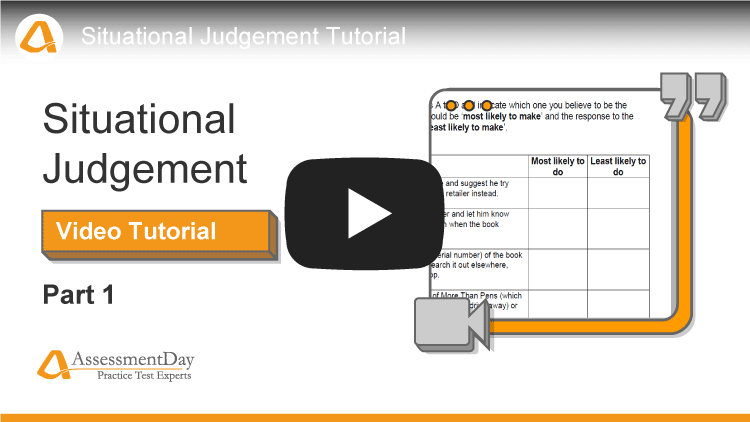Situational Judgement Test Advice
Need help to ensure you pass your Situational Judgement Test? Use this guide to help you improve your understanding of SJTs and develop a strategy in order to pass onto the next stage of assessments.
Page contents:
Jump to:What is a situational judgement test?
A situational judgement test (SJT) is an extremely popular assessment method used by employers across many industries. The main premise of an SJT is to test a candidates behavioural decision-making and thought processes when introduced to hypothetical work-related scenarios.
When given a scenario you will be presented with 4 or 5 possible actions that you could take, it's up to you to decide which is the most effective and least effective or be asked to rank them in order of effectiveness. If you want to know more about what situational judgement tests are, we cover that in more detail on our other page. But for now, let's proceed with the guide that will help you ace situational judgement tests!
How to tackle an SJT question
Make sure that you have researched the job role you are applying for thoroughly, this will help you to identify what sort of a person they require. How you should answer will depend on what the role demands of you. So an SJT doesn't necessarily have right or wrong answers, so let's go through an example...
The following video features Ben take you through a typical SJT style question, analysing the different answers available:

Our 8 top tips for situational judgement tests
The following eight tips are our best advice (along with the video above) in tackling a situational judgement test. If you digest this advice and take enough practice tests, you should find your SJT considerably easier.
Familiarise yourself with the tests
It's important to know what to expect when heading into an SJT. You want to be familiar with the format; know what is expected of you and be able to navigate the questions efficiently.
The best method for this is two-fold: Read up about them and practice them. As aforementioned, we have a page explaining everything to do with situational judgement tests and from there you can also take some practice SJTs.
Understand the role you're applying for and the required skills
You may feel that there is a uniform "correct" answer to a situation across all industries, however this may not be the case. Understanding the industry and the role will help you identify what elements may be deemed as important in a response. Some personality traits are particularly desirable in some fields, but less so in others. Consider what is important for the industry and the role you're applying for.
PRO TIP:
Often neglected, it's important to take into account the level of authority your potential role will possess. If it is a junior position, then responses that challenge/ or require lots of time and work from senior staff members may not be desired by the hiring company. A junior employer is not likely to delegate work so selecting an option that matches the status level of your role.
Now this part could be seen as controversial, as you should answer the test honestly with the responses that are most natural to your personality. However, each particular role will have certain personality traits that the hiring company are looking for. If the role you are applying for involves a lot of teamwork then it is likely that candidates who display good teamworking skills in their answer choices will be more favourable to the employer than, for example, selecting responses which dismiss others' opinions and focus on working purely independently. But if you do answer dishonestly then it could be the case that if you secure the job you may well not enjoy it.
Familiarising yourself with the role and the skills/personality that are required by the hiring company will allow you to better diagnose the most appropriate response.
Core competencies
Companies tend to use these assessments to measure core competencies. It is vital to ensure you are acquainted with the company and their values. Once you know the values of the company it is easier to understand the sort of candidate they are seeking.
Be in a suitable environment
This is a common tip for any test you have to take, but it is still important as ever. It's essential you are seated in an environment you have control over. You want to eliminate all distractions. Don't decide to sit the test in a coffee shop where there could be a large amount of background noise or where a waitress could disrupt you - the environment is not under your control. Be somewhere comfortable, like at home, and have people aware you are about to sit a test so no one comes in and distracts you.
It's also important to consider the time it will take to sit the assessment. Don't rush to fit it in an unrealistic time slot, or, if you are tired, don't try to quickly finish it so you can move on. This will only increase your chances of not passing this stage of the assessment. Ensure you have allowed for adequate time to sit the test - most SJTs do not have a time limit so there is no need to rush.
Read the instructions - this test could be different
Most situational judgement tests follow the same general format but there are differences you can encounter. When answering questions your responses may be asked in a few different formats. You may be asked to provide the most and least effective responses; you may be asked to rank the responses in order of effectiveness, you may even be asked to simply pick the one response you would take.
Almost all SJTs do not have a time limit, but it's important to read the instructions to make sure. Not reading the instructions could jeopardise all the hard work you put in practising for the test.
Identify the problem the question is highlighting
Be sure to clearly understand the issue or area that the question is addressing. When reading the question, try to clarify what specifically is the element that needs your attention. If you skim through the scenario without clearly identifying the issue you should diagnose, then you will be in a weaker position to tackle the question.
Only consider the options listed
Focus on the responses that are in front of you. It may be that the course of action that you would most naturally do is not listed as an option, but don't let this occupy your mind. Also be wary of making assumptions, try to mainly use the information that's given in the question. Analyse the responses that are provided and focus on their effectiveness and appropriateness.
Post-test thoughts...
After you've taken the test and you've been shown example job-scenarios, an important thing to ask is: Is this the career for me? Now a lot of you will be certain in the career paths you want to go down, but an SJT does offer a little glimpse into whether you will like the role you are applying for. The hypothetical scenarios you are presented with are not random but examples of situations someone in that role is likely to face. This can act as a good indicator as to whether it is a role you would enjoy. Of course, these are just scenarios and there's a lot more to working for a company than just some example day-to-day situations. Nevertheless, it is something to keep in mind.
Start practising quality tests with a free account
Practice makes perfect
- Learn from detailed solutions
- Track your progress

Additional psychometric test resources
We have lots of specialised and specific psychometric test advice waiting for you. Simply navigate over to our resources section where you can find all of our test advice, or click on one of the following links you may find useful:
